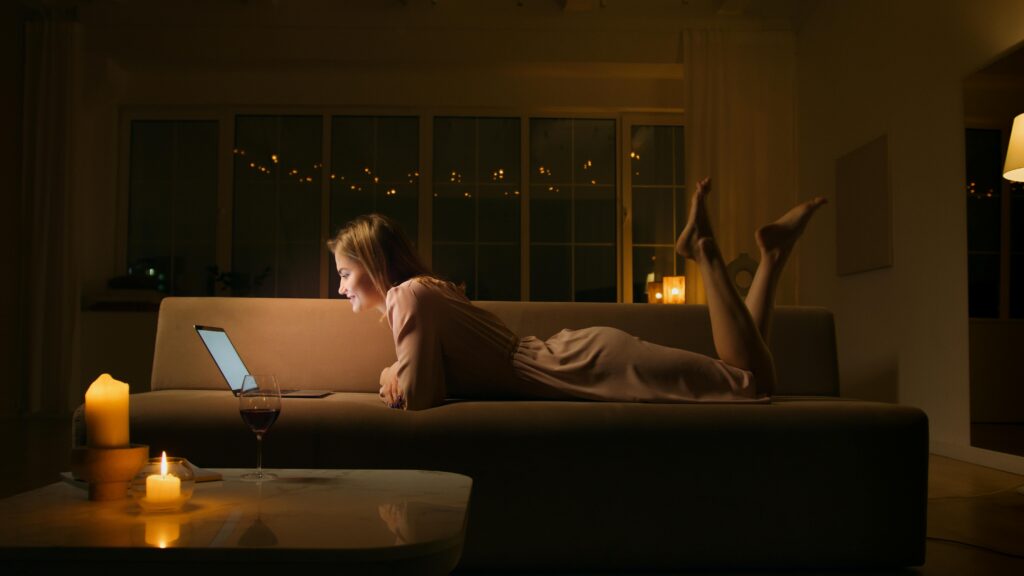Are camming sites and flirty convos with AI chatbots your next step toward mental wellness?
Maybe not your typical mental health go-tos, like journaling, mindfulness apps, or telehealth calls with a therapist, but for some, comfort is found in unexpected places. Late-night visits to erotic livestreams or brief, back-and-forth conversations with a chatbot can help some navigate complex feelings and feel supported.
It’s not always about the sex. Sometimes, we just need a distraction from everyday life. Sometimes, it’s about connection—feeling desired, heard, or just not alone for a little while. And for folks facing anxiety or depression, that can be enough to take the edge off.
“Sextech Use as a Potential Mental Health Reprieve: The Role of Anxiety, Depression, and Loneliness in Seeking Sex Online”, published by The Kinsey Institute, takes a deeper look at how our mental health may impact the way we engage with digital sexual technologies.
If you’re feeling depressed or anxious, are you more likely to use sextech?
It’s my emotional support screen
The correlation between mental health and sexual behavior isn’t a new topic. Researchers have known for a hot minute that when we’re feeling anxious, lonely, or depressed, we’re going to seek out things that make us feel safe (or at least distracted)—to cope. Sometimes that’s exercise, an adult beverage, or a ranty chat with a close friend. Sometimes, it’s sex.
Studies show that sexual satisfaction has been connected to a boost in mental wellness. In one paper, women with higher sexual satisfaction were less likely to feel depressed or anxious over time. In another study, teen girls with strong sexual wellbeing reported high self-esteem and fewer signs of depression. And on the flip side, folks who struggle with depression or anxiety often report less overall sexual satisfaction.
It’s not just about having sex, it’s the why we’re seeking sex. Researchers have documented hundreds of reasons why people are doing it. From wanting to feel connected, as a stress relief, or simply needing reassurance, emotional closeness is a major driver.
And with more of our lives happening online, those patterns are going digital: sexting, camming sites, erotic video games, AI chatbots, and even tech-driven sex toys (aka teledildonics).
Overall, previous research has focused on more traditional forms of adult content, like watching porn, and not interactive sextech. It also barely looked at the emotional why behind it.

Why is this study important?
Alexandra S. Marcotte, Ph.D., and colleagues asked: Could interactive sextech be a tool some people use to manage their mental health? If so, who’s using it and why?
They focused on three major emotional states, anxiety, depression, and loneliness, to see how each one might influence someone’s likelihood of using sextech. Do anxiety and depression explain why lonely folks might (or might not) engage in digital sexual behavior?
They were also interested in whether gender and sexual orientation made a difference.
To answer these questions, the authors surveyed 8,004 American adults, aged 18 and older. They asked the participants how often they felt anxious, depressed, and lonely using statements like: “My worries overwhelmed me,” “Little interest or pleasure in doing things,” and “I lack companionship.” They also asked how often they felt sexual desire.
When it came to sextech, they didn’t just ask about porn. They covered seven specific types of digital sexual behavior, like sending nudes (sexting), visiting cam sites, engaging in webcam livestreams, using virtual reality porn, playing an erotic video game, engaging in teledildonics (digitally connected sex toys), and sexually messaging with AI chatbots.
The research team analyzed how different mental health challenges (anxiety, depression, loneliness) were linked to sextech use, and if those links varied based on gender or sexual orientation.
What really drives sextech use
Out of the 8,004 folks surveyed, about 60% had never used any of the seven sextech types specified (sending nudes, camming, webcam livestreams, teledildonics, VR porn, erotic games, and AI chatbots). But nearly 30% had sexted, 18% had visited cam sites, 12% participated in a camming livestream, almost 14% had played a sexually explicit video game, and 9% had either used a tech-driven sex toy or chatted sexually with an AI chatbot.
So, who’s using the sextech, and why?
First, it’s not loneliness driving us toward these platforms. People who reported high levels of loneliness actually used sextech less. That includes heterosexual men, gay and bisexual men, and lesbian and bisexual women. However, for heterosexual women, loneliness didn’t make much of a difference—they didn’t use it less if they were lonely, and they didn’t use it more if they were lonely.
“Those who more lonely were less likely to engage with sextech.” (A. S. Marcotte, et al.)
Anxiety and depression
People who reported more depression and anxiety were more likely to use sextech, but this varied by gender and sexual orientation.
Heterosexual men and gay/bisexual men with higher depression scores used more sextech. Heterosexual women followed the same pattern, but a little less strongly. And lesbian/bisexual women? Depression didn’t impact their sextech use much at all.
The anxiety side had similar findings. More anxiety meant more sextech use for men (no matter their sexual orientation). And this was the same for lesbian/bisexual women, too. Interestingly, heterosexual women’s anxiety didn’t influence their sextech use, unlike the other groups in the study.
The authors found that depression, not anxiety, helped explain why lonely humans might use sextech. If loneliness led to a boost in depression, that depression could lead to more sextech use.

What does it mean?
Sextech isn’t a cure, but it might be a tool that folks use to cope and feel a little better, especially when they’re anxious or depressed. It might distract us from hard emotions or provide a brief moment of comfort. Maybe it’s about avoiding judgment or simply accessing something that feels personal and safe (when the outside world doesn’t).
Should we think of it as a mental health remedy? Nope, it’s not therapy. But it could be part of your toolkit, giving you short-term relief.
Of course, it’s not all upside. The research team was clear that sextech may not be risk-free. For some, digital sexual behavior may reinforce emotional avoidance or even worsen mental health challenges.
There’s no perfect answer. The study also doesn’t demonstrate cause and effect. We can’t say using sextech helps or hurts mental health. That said, most folks didn’t report using sextech because they were lonely. And for many, it seemed to coexist with their anxiety or depression, not necessarily worsening it.
As the researchers note: “Use of these technologies may serve as a mitigation strategy for people struggling with psychological well-being, potentially offering temporary alleviation of symptoms via stimulation that distracts from daily emotional challenges.”
In the end, sextech won’t fix everything. But it could open us to even more connection, self-exploration, and understanding; in ways we’re only beginning to discover.



